|
The railway navvies
The navvy was a phenomenon of the 19th century when public works such as the construction of new railways needed human muscle to shift massive quantities of earth, often at the rate of twenty tons a day for each man on site.
The word navvy is a shorter version of navigator, the name given to the canal builders of the 18th century and was inherited by the railwaymen. It was used more particularly to mean a man with a pick and shovel, an excavator as opposed to a bricklayer or a mason, and invariably referred to someone employed on the building of railways.
It was a rough and ready life that attracted itinerant workers from other countries, particularly Scotland and Ireland where the only alternative was ill-paid employment on the land. They were also prepared to live together, often in encampments by the line, and they invariably had an ability to eat heartily, drink heavily and fight fiercely and during Victorian times were easily recognisable by their distinctive dress of moleskin trousers, canvas shirts, velveteen square-tailed coats, hobnail boots, gaudy handkerchiefs and white felt hats with the brims turned up. They would also pay a high price, perhaps 15s., for a sealskin cap and their distinctive badge of a rainbow waistcoat.
The navvies came to the Bourne area to help build the railways. Their first
job was on the Bourne to Essendine link on which work began in the autumn of
1857. Such a large concentration of tough workers, renowned for their strong language, love of beer and immoral behaviour, was regarded with some concern by the people who lived locally
and there were many attempts to keep the men on the straight and narrow
path of Victorian righteousness. A director of the Bourne and Essendine
Railway Company responsible for the project was Mr John Lely Ostler of
Cawthorpe House, a local landowner of some repute, and a dedicated
Christian who sought to pass on his ideals to others and he was
responsible for bringing preachers to speak to the men in their off duty
hours, a practice that continued even after he died in June 1859.
The
Stamford Mercury, for instance, reported on Friday 30th March 1860:
"Mr E T Rawlinson of Grantham preached in an upper room in the Red
Hall, Bourn, on Tuesday evening last. The room was filled, the auditors
including several of the persons employed on the works of the Bourn and
Essendine railway. At the commencement of this line, the late J L Ostler
Esq was anxious that the spiritual welfare of the men at work on the line
should be attended to, and to this end he provided that they should be
visited and spoken to by Mr Rawlinson who, during the progress of the
work, has delivered many impressive discourses in the Red Hall and also
upon the works, which it is hoped have been useful, very good order having
prevailed amongst the men employed upon the line."
The
line was completed in 1860 but Ostler had laid firm foundation for this
evangelism to continue among the railway navvies in the Bourne area and
the practice of employing visiting preachers for their spiritual welfare
continued on other railway projects in the ensuing years, particularly the
line between Bourne and Little Bytham junction that opened in 1894. As the
railway progressed towards the town, particularly during the two years from 1891-93 that it took to build the last section through Little Bytham, Toft and Lound,
earnings were as high as £1 a week or even 30s. if on piecework, far higher than could be obtained
elsewhere and this attracted a motley collection of hardened labourers
from all parts of the British Isles.
By
this time, organised evangelism had taken root with the establishment of
the Navvy Mission Society, a Christian action group founded by a Yorkshire vicar, the Rev Lewis Moule Evans who actually worked as a navvy himself. He recruited ladies of means and Christian conviction who were able to devote their leisure time to evangelism by taking the word of God to most of the railway construction sites during the years of its existence between 1877 and 1918. The society has now become the Industrial Christian Fellowship but the records of those missionary days have been preserved in the library at Lambeth Palace and at the University of Leicester.
|
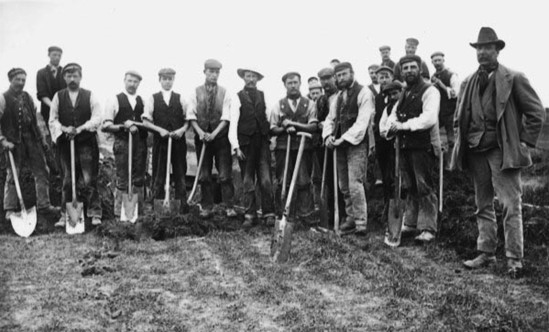 |
|
A gang of navvies laying rails for the last
stretch of the railway into Bourne in 1891-93 pause in their labours
to pose for the camera. They worked hard and drank hard and their
lifestyle attracted Christian evangelists who arrived to look after
their spiritual welfare. The bottom photograph shows navvies at work
on Toft Tunnel circa 1891. |
|
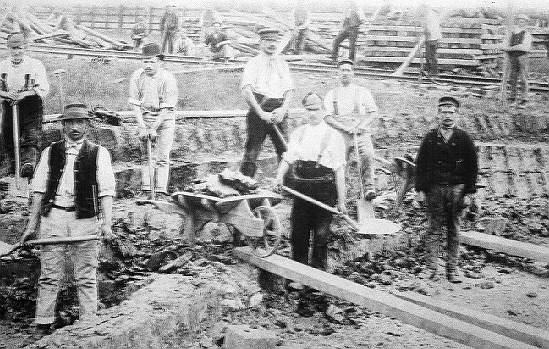 |
|
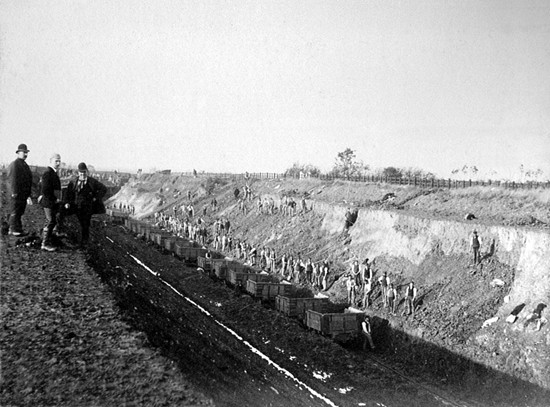 |
The society set up mission rooms at the Victoria Hall in Bourne, at Little Bytham and at Castle Bytham where it was officially opened by Lady Frances Cecil, and regular meetings and entertainments were arranged for the workers as an alternative to their usual pursuits. At Bourne, for instance, Mr A Moseley, son of the contractor Mr William Moseley, organised a concert of music including violin solos, songs and recitations at which, it was reported, "the humorous element met with hearty appreciation". The society sent missionaries to speak to the men and at Castle Bytham, Miss Spofford, who had been crusading among the workers engaged on building the Manchester Ship Canal, delivered what was described as "a very powerful and earnest address" on behalf of the Christian Excavators Union, an organisation associated with the Navvy Mission Society, and the men apparently listened to her with rapt attention.
The majority of the navvies were well behaved and many were sending money home to needy families. But there were those who spent all they earned on drink and often worked through the day while still drunk. Petty crime therefore was inevitable and navvies were convicted and fined and sometimes jailed by the courts for poaching and stealing, often poultry from local farms but also from each other and on one occasion a navvy absconded with the money from their sick club. The Midland Railway tried to keep law breaking, particularly drunkenness, under control by appointing special constables at 30s a week but the experiment was short-lived.
Fighting was also a way of life and regular bouts were held on Sundays to determine who should be Cock of the Camp for the following week. It was also the accepted
method of settling quarrels and many were badly injured in this way and there was at least one death during the construction of this railway. James Hook and Thomas Smith met in a bare-knuckle contest in a field near Wymondham at the far end of the line, The two had
quarrelled some time before and Hook insisted on finishing the argument. Smith refused but Hook's taunts became too much for him and the two of them slugged it out unmercifully until Hook was felled and collapsed in the shadow of a wall where he was later found to be dead. Smith gave himself up to the police and was sent for trial on a charge of manslaughter.
|
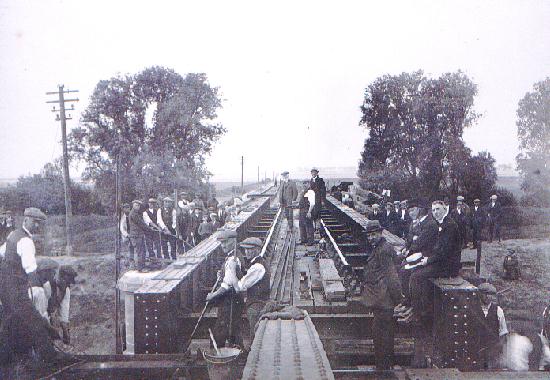
|
|
Navvies at work on
the bridge over the Bourne Eau near Twenty shortly before the line
opened in 1894. This picture appears to have been taken on the
occasion of a visit by the railway company directors to inspect
progress on the project and they can be seen seated on the right. |
Disease was also prevalent, even smallpox, and those who contracted it often carried on working without revealing their illness for fear of losing their weekly wages. The easy movement of labour and the communal and unhygienic conditions in which they lived contributed to its spread and Irish navvies working on the line and living in a common lodging house in South Street were responsible for the smallpox outbreak in Bourne in 1893 and which subsequently spread to the inmates of the workhouse in St Peter's Road.
But the age of the navvy was not to last. Most of the railway work was done by the beginning of the 20th century and although the Navvy Missionary Society was still handing out 10,000 copies of their quarterly newsletters, the recipients were scattered and there were no longer large concentrations in any one place. New machinery has taken the place of the pick and shovel and although itinerant labour is now used for motorways and other major building projects, these workers now command high wages that enable them live
comfortably in boarding houses and hotels or even in their own homes. But the railways we see today remain the legacy of the age of the
navvy.
|
ENTERTAINING THE NAVVIES |
|
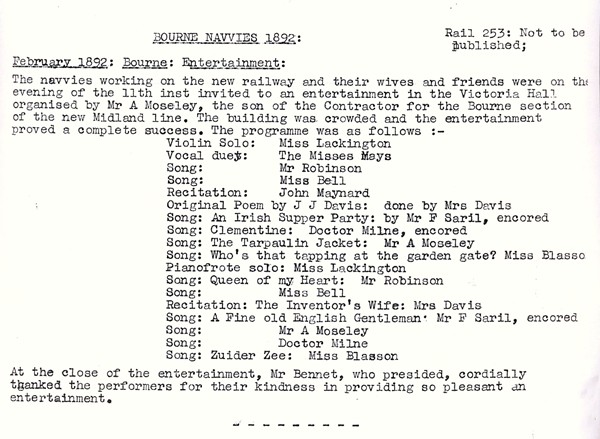 |
|
The navvies were given regular concerts by local
people to keep them entertained and this is the programme for such an
event at the Victoria Hall in February 1892, published by the railway
company in its monthly Bourne Navvies' newsletter. |
See also John
Lely Ostler The smallpox outbreak
Return to The railways

Go to:
Main Index Villages
Index
|




